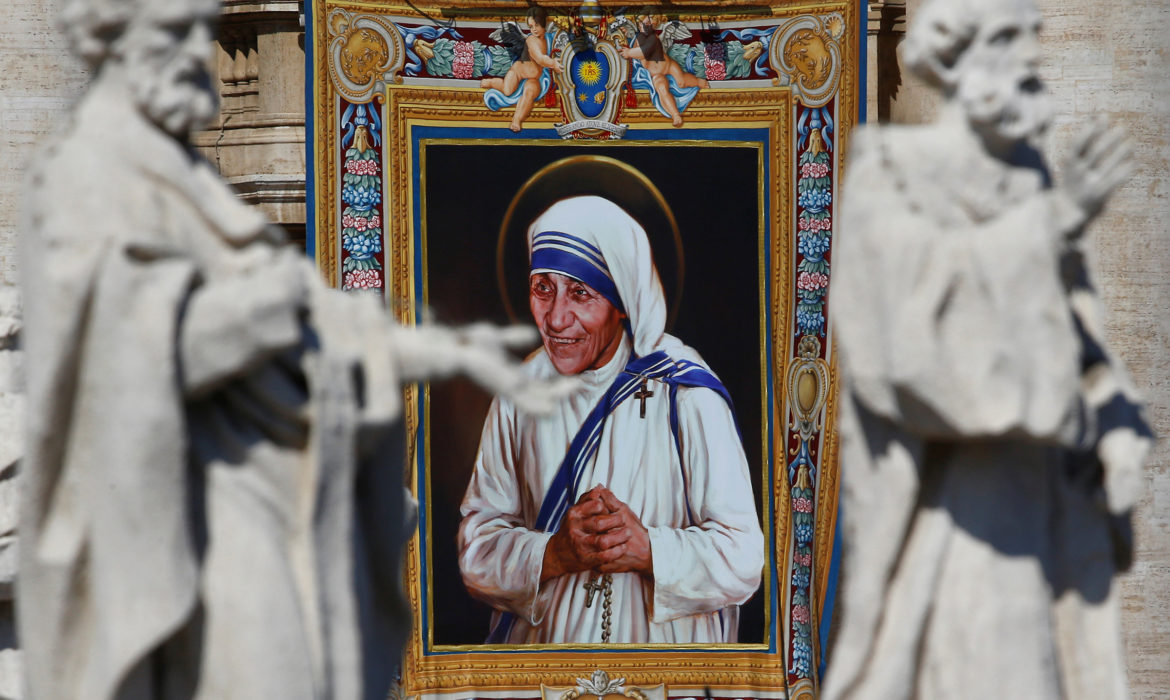
(RNS) — Most human beings living in the last quarter of the 20th century knew Mother Teresa by name and appearance and could identify her as the saint of the gutters of Calcutta. She was regularly named as one of the most recognized and influential people in the world. Now, 25 years after her death on Sept. 5, 1997, Teresa of Calcutta, as she is known since her canonization in 2016, is a beloved saint — and the first great saint of the television era.
What really is there still to say about her?
Quite a bit, as it turns out.
The stories of both her public and private lives remain little known. We also continue to grapple with the extraordinary things she did, as well as the way she interpreted the vocation of any would-be follower of Jesus.
Perhaps not quite as universally familiar as it was when she was alive, her striking physical appearance remains vivid in the memories of those who were adults then. It always included the sari — the traditional outer garment of women of the Indian subcontinent — that she’d chosen as the religious uniform of the congregation she founded in 1950: simple white cotton bordered with three blue stripes. She was small in stature, but fiercely strong and always determined. Do an internet search and you will find not a single photograph of her appearing weary, winded or (outside of moments of prayer) at rest.
Yet when we saw her ubiquitous face or watched her at work with children and the dying, we had no idea of the things going on within her that we would learn after her death.
Her surroundings in Calcutta, now Kolkata, were central to her life and her story. Images of the women, men and children of that city’s streets were familiar. They lay there, destitute, malnourished and very much alone, even if they were lying near others. Then a tiny woman in a white and blue sari and sandals would bend over to greet them, one by one. She reached out a hand and touched an arm or a shoulder. That is St. Teresa of Calcutta, or “Mother Teresa,” as the world still most often remembers her, making her daily rounds.

Mother Teresa holds a child in 1971. RNS archive photo. Photo courtesy of the Presbyterian Historical Society
Other things become clear if you study the photographs or look closely at the videos and documentaries. She had large hands for a woman her size. Mother Teresa was tiny. She stood a mere 5 feet tall in sandals. Her hands were thick, coarse, working hands, and she was a hugger, particularly with infants and toddlers. She would pull children tightly to her cheek, one arm underneath the torso, the other propping up the neck, the way a natural mother holds a child. A joyous smile was common on her face. Yet she was a serious saint, fiercely dedicated to living her calling, and the same face that bore easy smiles was also marked often by a furrowed brow and pursed determination around the lips. The images are difficult to forget and easy to find, and her story is so well known that we don’t really know her.
To the intuitive sensibility of the Catholic faithful, Mother Teresa is revered, and her role as an advocate in heaven unquestioned, in the way that only a few other saints of the modern era, such as Therese of Lisieux and Padre Pio, have been regarded. Mother Teresa holds a unique distinction, however, as the first great saint of the television age.
We came to know her through electronically and digitally transmitted video images, and because of that, we felt we knew her in a way we could not have known any of the saints before her. Through television, we made sense of Mother Teresa, often in real time. The inspiration she took from the words of St. Therese of Lisieux, to be little for God, became more powerful when we saw it — and we saw it often — in action.
We were aware of her activities and movement and influence, as well as the immense compassion she gave to those whom she aided. All of this was more vivid and immediate to people around the globe through the powerful communications technology of the day.
Television has “made” saints in ways not unlike how they were made in the pre-modern era, when popular acclaim among the populus Dei is what often determined canonical status: The people of God simply demanded it. In Mother’s case (and we will often refer to her simply as “Mother”), prayers for her intercession — if we had statistics for such things — probably outstripped every other saint before her by a multiple of 10.

A tapestry depicting Mother Teresa is seen in the facade of St. Peter’s Basilica during a Mass, celebrated by Pope Francis, for her canonization in St. Peter’s Square at the Vatican on Sept. 4, 2016. (Stefano Rellandini/Reuters)
Despite all the evidence we had in front of us while she was alive, it is safe to conclude that, nearly a decade after her official canonization and a quarter century after her death, her reputation is still being sorted out. We are learning new things all the time.
Mother Teresa first appeared on the international stage in 1969, when Malcolm Muggeridge, the popular English journalist, presenter and recent convert to Christianity, took a film crew to interview her. He became Mother’s most ardent early supporter.
He wrote: “The wholly dedicated like Mother Teresa do not have biographies. Biographically speaking, nothing happens to them. To live for, and in, others, as she and the Sisters of the Missionaries of Charity do, is to eliminate happenings, which are a factor of the ego and the will.”
The documentary that Muggeridge produced, “Something Beautiful for God,” changed everything for her work in India and then throughout the world. But what Muggeridge wrote was either disingenuous or naïve.
Her life was absolutely eventful. She was often at the center of issues of the day. In fact, she put herself there, and she spent many, many days among the most powerful people in the world.

Mother Teresa gestures as she talks to President George Bush as the two meet on Dec. 9, 1991, in the Oval office at the White House. (Rick Wilking/Reuters)
This is also why we continue to be fascinated by her story. Her life’s work became so iconic that she too became an icon, and it’s important to see her for who she was in the context of extraordinary events throughout the 20th century.
Few people knew anything about her personal life. This became particularly poignant and evident after her death, when we learned of her doubts about the existence of God. Most of the biographies were written before her cause for canonization was underway, and so those biographers did not have access to the material we now possess revealing Mother’s doubts, serious questions of faith and spiritual loneliness. The revelations that surrounded her as her cause for canonization heated up were, to put it mildly, shocking.
The spiritual darkness Mother Teresa experienced was always there; at times, it was “active and crescent.” In fact, the environment of her ministry could naturally have incubated the darkness. The postulator of her cause for canonization said as much when he connected the beginning of her time working in the slums with the beginning of her experience of darkness and aridity: “As she started her mission to the poor she was plunged into the dark reality of desolation that those whom she served experience: the feeling that God was no longer present, that He no longer loved her or cared for her.”
Consistently, however, for all those decades, and visible to all of us who were able to watch, Mother went about trying to be the presence of God in situations where only God’s absence might otherwise have been felt.
(Jon M. Sweeney is the author of the new biography “Teresa of Calcutta: Dark Night, Active Love,” from which this article is adapted with permission. The views expressed in this commentary do not necessarily reflect those of Religion News Service.)
